Narrow Results By
Subject
- Advertising Medium 3
- Advertising Medium - Flyer 1
- Advertising Medium - Signs and Signboards 1
- Agriculture 1
- Agriculture - Farms 1
- Animal Husbandry Tools and Equipment 1
- Animals - Birds 1
- Animals - Dogs 2
- Armament - Munitions 1
- Buildings - Commercial - Restaurants 1
- Buildings - Heritage 1
- Buildings - Public - Post Offices 1
mug
https://search.heritageburnaby.ca/link/museumartifact87490
- Repository
- Burnaby Village Museum
- Accession Code
- BV015.35.96
- Description
- mug, Girl Guide; navy blue glazed ceramic mug; "Keeping the Spirit / Alive!" in purple on one side, along with trefoil logo; "TREFOIL GUILD" in purple on other side, along with Guild flame logo; "TAMS / MADE IN ENGLAND" embossed on bottom.
- Object History
- Mugs previously owned by May Aikenhead (Elizabeth May). May was a member of the Burnaby Royal Trefoil Guild for many years.
- Category
- 04.Tools & Equipment for Materials
- Classification
- Food Service T&E - - Drinking Vessels
- Object Term
- Mug
- Subjects
- Organizations - Girls' Societies and Clubs
- Organizations - Women's Societies and Clubs
- Food Service Tools and Equipment
Images
New Haven
https://search.heritageburnaby.ca/link/museumdescription13525
- Repository
- Burnaby Village Museum
- Date
- Jan. 2001
- Collection/Fonds
- Burnaby Village Museum Photograph collection
- Description Level
- Item
- Physical Description
- 1 photograph : col. ; 5.3 x 10 cm
- Scope and Content
- Photograph of signage outside of New Haven Correctional Centre. Signage reads, "4250 / NEW HAVEN / NEW HAVEN / CORRECTIONAL CENTRE / VISITORS PLEASE REPORT / TO GENERAL OFFICE / IN MAIN BUILDING".
- Repository
- Burnaby Village Museum
- Collection/Fonds
- Burnaby Village Museum Photograph collection
- Description Level
- Item
- Physical Description
- 1 photograph : col. ; 5.3 x 10 cm
- Scope and Content
- Photograph of signage outside of New Haven Correctional Centre. Signage reads, "4250 / NEW HAVEN / NEW HAVEN / CORRECTIONAL CENTRE / VISITORS PLEASE REPORT / TO GENERAL OFFICE / IN MAIN BUILDING".
- History
- In 1937 New Haven Correctional Centre was established as the British Columbia Training School on the southeast side of Marine Drive in Burnaby (4250 Marine Drive). Sections of Sussex and Patterson Avenues bordered the estate. Originally, the facility housed nineteen inmates with two staff and was one of the first initiatives in Canada to segregate young adult inmates into a separate institution apart from adults. This was part of the Borstal system that started in England whereby young male offenders between the ages of sixteen and twenty one were trained to earn an honest living. Alterations and additions to the estate took place between December 1937 and October 1939 so that more inmates could be accomodated. Five new cottages were built that could hold up to forty people. Except for the plastering and lighting, all work on the new cottages was done by the inmates. On October 29, 1939, the Lieutenant-Governor Eric Hamber formally opened the New Haven Borstal School. World War II interrupted full development of the intstitution and it was closed in 1941 when the inmates were were conscripted into the army. Between 1941 and 1947 the Deaf and Blind Institute were housed at New Haven. In 1947, the New Haven Borstal School returned to the estate. New additions were added to old buildings and new additional buildings were erected on the site over the years including a warden's house on the east grounds and a barn and gymnasium. In the 1970s an equipment shed was added along with another dormitory and a variety of small sheds and storage buildings. The correctional centre officially closed in March 2001.
- Subjects
- Public Services - Correctional
- Geographic Access
- Marine Drive
- Street Address
- 4250 Marine Drive
- Accession Code
- BV020.5.869
- Access Restriction
- No restrictions
- Reproduction Restriction
- No known restrictions
- Date
- Jan. 2001
- Media Type
- Photograph
- Historic Neighbourhood
- Fraser Arm (Historic Neighbourhood)
- Planning Study Area
- Suncrest Area
- Scan Resolution
- 600
- Scan Date
- 25-Aug-2020
- Scale
- 100
- Notes
- Title based on contents of photograph
- Photograph processing stamp on front of photograph reads: "'01_1_13"
- Historical information based on notes from Mary Forsyth's research notes "New Haven" MSS185-018
Images
New Haven building and parking lot
https://search.heritageburnaby.ca/link/museumdescription13528
- Repository
- Burnaby Village Museum
- Date
- Jan. 2001
- Collection/Fonds
- Burnaby Village Museum Photograph collection
- Description Level
- Item
- Physical Description
- 1 photograph : col. ; 5.3 x 10 cm
- Scope and Content
- Photograph of the main building and parking lot of New Haven Correctional Centre located on Marine Drive in Burnaby.
- Repository
- Burnaby Village Museum
- Collection/Fonds
- Burnaby Village Museum Photograph collection
- Description Level
- Item
- Physical Description
- 1 photograph : col. ; 5.3 x 10 cm
- Scope and Content
- Photograph of the main building and parking lot of New Haven Correctional Centre located on Marine Drive in Burnaby.
- History
- In 1937 New Haven Correctional Centre was established as the British Columbia Training School on the southeast side of Marine Drive in Burnaby (4250 Marine Drive). Sections of Sussex and Patterson Avenues bordered the estate. Originally, the facility housed nineteen inmates with two staff and was one of the first initiatives in Canada to segregate young adult inmates into a separate institution apart from adults. This was part of the Borstal system that started in England whereby young male offenders between the ages of sixteen and twenty one were trained to earn an honest living. Alterations and additions to the estate took place between December 1937 and October 1939 so that more inmates could be accomodated. Five new cottages were built that could hold up to forty people. Except for the plastering and lighting, all work on the new cottages was done by the inmates. On October 29, 1939, the Lieutenant-Governor Eric Hamber formally opened the New Haven Borstal School. World War II interrupted full development of the intstitution and it was closed in 1941 when the inmates were were conscripted into the army. Between 1941 and 1947 the Deaf and Blind Institute were housed at New Haven. In 1947, the New Haven Borstal School returned to the estate. New additions were added to old buildings and new additional buildings were erected on the site over the years including a warden's house on the east grounds and a barn and gymnasium. In the 1970s an equipment shed was added along with another dormitory and a variety of small sheds and storage buildings. The correctional centre officially closed in March 2001.
- Subjects
- Public Services - Correctional
- Geographic Access
- Marine Drive
- Street Address
- 4250 Marine Drive
- Accession Code
- BV020.5.872
- Access Restriction
- No restrictions
- Reproduction Restriction
- No known restrictions
- Date
- Jan. 2001
- Media Type
- Photograph
- Historic Neighbourhood
- Fraser Arm (Historic Neighbourhood)
- Planning Study Area
- Suncrest Area
- Scan Resolution
- 600
- Scan Date
- 25-Aug-2020
- Scale
- 100
- Notes
- Title based on contents of photograph
- Photograph processing stamp on front of photograph reads: "'01_1_13"
- Historical information based on notes from Mary Forsyth's research notes "New Haven" MSS185-018
Images
New Haven building and parking lot
https://search.heritageburnaby.ca/link/museumdescription13529
- Repository
- Burnaby Village Museum
- Date
- Jan. 2001
- Collection/Fonds
- Burnaby Village Museum Photograph collection
- Description Level
- Item
- Physical Description
- 1 photograph : col. ; 5.3 x 10 cm
- Scope and Content
- Photograph of the main building and parking lot of New Haven Correctional Centre located on Marine Drive in Burnaby.
- Repository
- Burnaby Village Museum
- Collection/Fonds
- Burnaby Village Museum Photograph collection
- Description Level
- Item
- Physical Description
- 1 photograph : col. ; 5.3 x 10 cm
- Scope and Content
- Photograph of the main building and parking lot of New Haven Correctional Centre located on Marine Drive in Burnaby.
- History
- In 1937 New Haven Correctional Centre was established as the British Columbia Training School on the southeast side of Marine Drive in Burnaby (4250 Marine Drive). Sections of Sussex and Patterson Avenues bordered the estate. Originally, the facility housed nineteen inmates with two staff and was one of the first initiatives in Canada to segregate young adult inmates into a separate institution apart from adults. This was part of the Borstal system that started in England whereby young male offenders between the ages of sixteen and twenty one were trained to earn an honest living. Alterations and additions to the estate took place between December 1937 and October 1939 so that more inmates could be accomodated. Five new cottages were built that could hold up to forty people. Except for the plastering and lighting, all work on the new cottages was done by the inmates. On October 29, 1939, the Lieutenant-Governor Eric Hamber formally opened the New Haven Borstal School. World War II interrupted full development of the intstitution and it was closed in 1941 when the inmates were were conscripted into the army. Between 1941 and 1947 the Deaf and Blind Institute were housed at New Haven. In 1947, the New Haven Borstal School returned to the estate. New additions were added to old buildings and new additional buildings were erected on the site over the years including a warden's house on the east grounds and a barn and gymnasium. In the 1970s an equipment shed was added along with another dormitory and a variety of small sheds and storage buildings. The correctional centre officially closed in March 2001.
- Subjects
- Public Services - Correctional
- Geographic Access
- Marine Drive
- Street Address
- 4250 Marine Drive
- Accession Code
- BV020.5.873
- Access Restriction
- No restrictions
- Reproduction Restriction
- No known restrictions
- Date
- Jan. 2001
- Media Type
- Photograph
- Historic Neighbourhood
- Fraser Arm (Historic Neighbourhood)
- Planning Study Area
- Suncrest Area
- Scan Resolution
- 600
- Scan Date
- 25-Aug-2020
- Scale
- 100
- Notes
- Title based on contents of photograph
- Photograph processing stamp on front of photograph reads: "'01_1_13"
- Historical information based on notes from Mary Forsyth's research notes "New Haven" MSS185-018
Images
New Haven building and parking lot
https://search.heritageburnaby.ca/link/museumdescription13530
- Repository
- Burnaby Village Museum
- Date
- Jan. 2001
- Collection/Fonds
- Burnaby Village Museum Photograph collection
- Description Level
- Item
- Physical Description
- 1 photograph : col. ; 5.3 x 10 cm
- Scope and Content
- Photograph of the main building and cars in parking lot of New Haven Correctional Centre located on Marine Drive in Burnaby.
- Repository
- Burnaby Village Museum
- Collection/Fonds
- Burnaby Village Museum Photograph collection
- Description Level
- Item
- Physical Description
- 1 photograph : col. ; 5.3 x 10 cm
- Scope and Content
- Photograph of the main building and cars in parking lot of New Haven Correctional Centre located on Marine Drive in Burnaby.
- History
- In 1937 New Haven Correctional Centre was established as the British Columbia Training School on the southeast side of Marine Drive in Burnaby (4250 Marine Drive). Sections of Sussex and Patterson Avenues bordered the estate. Originally, the facility housed nineteen inmates with two staff and was one of the first initiatives in Canada to segregate young adult inmates into a separate institution apart from adults. This was part of the Borstal system that started in England whereby young male offenders between the ages of sixteen and twenty one were trained to earn an honest living. Alterations and additions to the estate took place between December 1937 and October 1939 so that more inmates could be accomodated. Five new cottages were built that could hold up to forty people. Except for the plastering and lighting, all work on the new cottages was done by the inmates. On October 29, 1939, the Lieutenant-Governor Eric Hamber formally opened the New Haven Borstal School. World War II interrupted full development of the intstitution and it was closed in 1941 when the inmates were were conscripted into the army. Between 1941 and 1947 the Deaf and Blind Institute were housed at New Haven. In 1947, the New Haven Borstal School returned to the estate. New additions were added to old buildings and new additional buildings were erected on the site over the years including a warden's house on the east grounds and a barn and gymnasium. In the 1970s an equipment shed was added along with another dormitory and a variety of small sheds and storage buildings. The correctional centre officially closed in March 2001.
- Subjects
- Public Services - Correctional
- Geographic Access
- Marine Drive
- Street Address
- 4250 Marine Drive
- Accession Code
- BV020.5.874
- Access Restriction
- No restrictions
- Reproduction Restriction
- No known restrictions
- Date
- Jan. 2001
- Media Type
- Photograph
- Historic Neighbourhood
- Fraser Arm (Historic Neighbourhood)
- Planning Study Area
- Suncrest Area
- Scan Resolution
- 600
- Scan Date
- 25-Aug-2020
- Scale
- 100
- Notes
- Title based on contents of photograph
- Photograph processing stamp on front of photograph reads: "'01_1_13"
- Historical information based on notes from Mary Forsyth's research notes "New Haven" MSS185-018
Images
New Haven buildings
https://search.heritageburnaby.ca/link/museumdescription13527
- Repository
- Burnaby Village Museum
- Date
- Jan. 2001
- Collection/Fonds
- Burnaby Village Museum Photograph collection
- Description Level
- Item
- Physical Description
- 1 photograph : col. ; 5.3 x 10 cm
- Scope and Content
- Photograph of the main building and workshop building inside of New Haven Correctional Centre located on Marine Drive in Burnaby.
- Repository
- Burnaby Village Museum
- Collection/Fonds
- Burnaby Village Museum Photograph collection
- Description Level
- Item
- Physical Description
- 1 photograph : col. ; 5.3 x 10 cm
- Scope and Content
- Photograph of the main building and workshop building inside of New Haven Correctional Centre located on Marine Drive in Burnaby.
- History
- In 1937 New Haven Correctional Centre was established as the British Columbia Training School on the southeast side of Marine Drive in Burnaby (4250 Marine Drive). Sections of Sussex and Patterson Avenues bordered the estate. Originally, the facility housed nineteen inmates with two staff and was one of the first initiatives in Canada to segregate young adult inmates into a separate institution apart from adults. This was part of the Borstal system that started in England whereby young male offenders between the ages of sixteen and twenty one were trained to earn an honest living. Alterations and additions to the estate took place between December 1937 and October 1939 so that more inmates could be accomodated. Five new cottages were built that could hold up to forty people. Except for the plastering and lighting, all work on the new cottages was done by the inmates. On October 29, 1939, the Lieutenant-Governor Eric Hamber formally opened the New Haven Borstal School. World War II interrupted full development of the intstitution and it was closed in 1941 when the inmates were were conscripted into the army. Between 1941 and 1947 the Deaf and Blind Institute were housed at New Haven. In 1947, the New Haven Borstal School returned to the estate. New additions were added to old buildings and new additional buildings were erected on the site over the years including a warden's house on the east grounds and a barn and gymnasium. In the 1970s an equipment shed was added along with another dormitory and a variety of small sheds and storage buildings. The correctional centre officially closed in March 2001.
- Subjects
- Public Services - Correctional
- Geographic Access
- Marine Drive
- Street Address
- 4250 Marine Drive
- Accession Code
- BV020.5.871
- Access Restriction
- No restrictions
- Reproduction Restriction
- No known restrictions
- Date
- Jan. 2001
- Media Type
- Photograph
- Historic Neighbourhood
- Fraser Arm (Historic Neighbourhood)
- Planning Study Area
- Suncrest Area
- Scan Resolution
- 600
- Scan Date
- 25-Aug-2020
- Scale
- 100
- Notes
- Title based on contents of photograph
- Photograph processing stamp on front of photograph reads: "'01_1_13"
- Historical information based on notes from Mary Forsyth's research notes "New Haven" MSS185-018
Images
nutcracker
https://search.heritageburnaby.ca/link/museumartifact25962
- Repository
- Burnaby Village Museum
- Accession Code
- HV975.110.13
- Description
- Nutcracker set; nutcracker and seven nutpicks
- Object History
- Object was used by donor's maternal grand-parents, the Dales of Naseby, Lincolnshire, England. It was inherited by the donor and used in Elworth house when it was occupied by the Batemans' from 1920-1935.
- Category
- 04.Tools & Equipment for Materials
- Object Term
- Nutcracker
- Subjects
- Food Processing Tools and Equipment
- Names
- Bateman Family
Images
Our first signaller
https://search.heritageburnaby.ca/link/museumdescription20592
- Repository
- Burnaby Village Museum
- Date
- 1925
- Collection/Fonds
- David Geoffrey Llewellyn collection
- Description Level
- Item
- Physical Description
- 1 photograph : b&w ; 6 x 3.5 cm
- Scope and Content
- Photograph of member of the 2nd Burnaby Boy Scout troop holding up his signal flag. The 2nd Burnaby Boy Scout troop went on a hike on Easter weekend down the Fraser River from New Westminster to Sunbury (North Delta). The troop was accompanied by Assistant Scout Master Jack Allen of the 1st New Wes…
- Repository
- Burnaby Village Museum
- Collection/Fonds
- David Geoffrey Llewellyn collection
- Description Level
- Item
- Physical Description
- 1 photograph : b&w ; 6 x 3.5 cm
- Scope and Content
- Photograph of member of the 2nd Burnaby Boy Scout troop holding up his signal flag. The 2nd Burnaby Boy Scout troop went on a hike on Easter weekend down the Fraser River from New Westminster to Sunbury (North Delta). The troop was accompanied by Assistant Scout Master Jack Allen of the 1st New Westminster Troop and Scoutmaster William Mundy of the 2nd Deptford Troop, London, England.
- Names
- Boy Scouts of Canada
- Accession Code
- BV995.8.23
- Access Restriction
- No restrictions
- Reproduction Restriction
- No known restrictions
- Date
- 1925
- Media Type
- Photograph
- Scan Resolution
- 600
- Notes
- Title based on contents of photograph
- Photograph is part of photograph album BV995.8.1, pasted to page 6
- Inscription in white ink on page of album reads: "EASTER HIKE / 1925 / OUR FIRST SIGNALLER"
Images
Our Journey
https://search.heritageburnaby.ca/link/museumdescription9682
- Repository
- Burnaby Village Museum
- Date
- 2016
- Collection/Fonds
- Burnaby Village Museum Film and Video collection
- Description Level
- Item
- Physical Description
- 1 video recording (mp4) (5 min.) : digital, 25 fps, col., sd., stereo
- Scope and Content
- Our Journey is a tribute to Judy Schulz's mother who helped raise Judy's two daughters while Judy maintained her career. The film celebrates four generations of women in Judy's family, including her mother, herself, her daughters, and her grand-daughters. Judy's mother, Mrs. Suet Ping Yip, was born…
- Repository
- Burnaby Village Museum
- Collection/Fonds
- Burnaby Village Museum Film and Video collection
- Description Level
- Item
- Physical Description
- 1 video recording (mp4) (5 min.) : digital, 25 fps, col., sd., stereo
- Scope and Content
- Our Journey is a tribute to Judy Schulz's mother who helped raise Judy's two daughters while Judy maintained her career. The film celebrates four generations of women in Judy's family, including her mother, herself, her daughters, and her grand-daughters. Judy's mother, Mrs. Suet Ping Yip, was born in 1922, and passed away in 2008. Judy was born in Hong Kong in 1955, and immigrated to Canada as an adult, later sponsoring her parents to join her. All of her five siblings soon followed. Judy's mother quit her job when Judy had her second daughter and helped to raise the two girls. Judy remembers her as a smart, kind, and hard-working mother and devoted grandmother. The girls knew her as "Pau Pau." Judy is proud to now be a "Pau Pau" herself, to two beautiful grand-daughters.
- History
- Judy Schulz has been a resident of Burnaby since 1980. She was born in Hong Kong and left home at age 17 first to England, and then immigrating to Canada in 1974. She originally settled in Vancouver. Though she had no family when she first arrived in Canada, her parents and all five of her siblings soon joined her in Canada. She worked in the medical field, and is now retired, but continues to live in Burnaby with Confederation Park as a favorite place to spend time.
- Creator
- Schulz, Judy
- Other Title Information
- title supplied by film maker
- Subjects
- Persons - Chinese Canadians
- Names
- Schulz, Judy
- Accession Code
- BV016.37.13
- Access Restriction
- No restrictions
- Reproduction Restriction
- May be restricted by third party rights
- Date
- 2016
- Media Type
- Moving Images
- Notes
- Transcribed title
Images
Video
Our Journey, 2016
pharmaceutical bottle
https://search.heritageburnaby.ca/link/museumartifact30764
- Repository
- Burnaby Village Museum
- Accession Code
- HV972.3.6
- Description
- The item is a bulk product stocked by a pharmacy. Up until the 1950s, pharmacists provided most prescription medications by creating compounds of bulk products that were given to customers as pills, salves, or tonics. Large wide-mouthed amber glass (brown) bottle with brown plastic lid, three-quarters full with white powder. Paper commercial label with markings: "[company logo] / MANUFACTURED BY / HOWARDS & SONS LTD. / ILFORD NEAR LONDON. / MAGNES. OXID. POND. P.B. / (Magnesia Ponderosa) / HOWARDS SPECIAL / 1-lb / Printed in England". Black and white label with contents labelled in red.
- Object History
- This item originates from the Cedar Cottage Pharmacy in Vancouver.
- Classification
- Chemical T&E
- Marks/Labels
- Paper commercial label with markings: "[company logo] / MANUFACTURED BY / HOWARDS & SONS LTD. / ILFORD NEAR LONDON. / MAGNES. OXID. POND. P.B. / (Magnesia Ponderosa) / HOWARDS SPECIAL / 1-lb / Printed in England". Black and white label with contents labelled in red.
- Names
- Cedar Cottage Pharmacy
- Geographic Access
- Vancouver
Images
photographic medallion with frame
https://search.heritageburnaby.ca/link/museumartifact88888
- Repository
- Burnaby Village Museum
- Accession Code
- BV007.20.2
- Description
- photographic medallion with frame; circular gold-tone metal frame with sepia photograph of Rhoda Mae Jeffers as a young girl [c.1915]; the photograph was wrapped around a round metal button, 15 cm in diameter and treated with a coating to increase its rigidity. "Columbia Medallion Studios Chicago" is stamped on the metal frame back; fold out wire stand.
- Object History
- Rhoda Maie Jeffers (middle name also spelled Mae) was born in July 1, 1904 in River Hebert, Nova Scotia to Albert Clifford Jeffers (1877 - 1967) and Eldora McAloney (1879 - 1978). The family moved to British Columbia in 1912, living in Vancouver at various addresses before moving to Burnaby around 1950 residing at 4254 Charles Street. Albert and Eldora Jeffers had three children; Rhoda Maie (Mae), Sarah Etta "Muriel" (later Webster) and Charles Kenneth Leroy (1906-1970). Rhoda began teaching in Grand Forks in 1922 and one of her early teaching posts included Eriksdale, Manitoba. Rhoda divided her teaching career between Alberta, Lake Cowichan, Agassiz and North Delta. In 1952, Rhoda worked as an exchange teacher in England and in 1957, Rhoda graduated from UBC with a Bachelor of Education (secondary specialization). Due to a severe injury in 1969, Rhoda was forced to retire and sometime after, she moved in with her parents at 4254 Charles Street. Rhoda continued to reside at this address until a year before her death in 1990.
- Reference
- https://www.madeinchicagomuseum.com/single-post/columbia-medallion-studios?_hsenc=p2ANqtz-_g5t1vBrql9n5oDjAosxH0GjqU9GuMWlpPKweddT3CO2jG-_K3e51Ti940tk2p_e_Lx9Ol&utm_campaign=Weekly%20Newsletters&utm_medium=email&utm_source=hs_email
- Category
- 08. Communication Artifacts
- Classification
- Documentary Artifacts - - Graphic Documents
- Object Term
- Photograph
- Measurements
- Diameter: 15.5 cm
- Height: .5 cm
- Country Made
- United States of America
- Province Made
- Illinois
- Site/City Made
- Chicago
- Names
- Jeffers, Rhoda Mae
Images
plate
https://search.heritageburnaby.ca/link/museumartifact457
- Repository
- Burnaby Village Museum
- Accession Code
- HV971.12.142
- Description
- Plate, shows turkey in a field in centre; elaborate border of flowers on sepia ground; line on edge where flowers are abruptly cut off, bad transfer? ; on bottom is "Wedgewood" (stamped), and in black, "Etruria England", "Wedgewood"; plate appears to have a large crack, mended with tape since removed
- Object History
- Object belonged to Alfred Bingham, an early Burnaby resident and activist.
- Category
- 04.Tools & Equipment for Materials
- Classification
- Food Service T&E - - Eating Vessels
- Object Term
- Dish, Eating
- Marks/Labels
- Wedgewoor / Etruria England
- Subjects
- Food Service Tools and Equipment
- Names
- Bingham, Alfred "Alf"
Images
Pond and bridge at New Haven
https://search.heritageburnaby.ca/link/museumdescription13531
- Repository
- Burnaby Village Museum
- Date
- Jan. 2001
- Collection/Fonds
- Burnaby Village Museum Photograph collection
- Description Level
- Item
- Physical Description
- 1 photograph : col. ; 5.3 x 10 cm
- Scope and Content
- Photograph of pond and bridge at New Haven Correctional Centre located on Marine Drive in Burnaby.
- Repository
- Burnaby Village Museum
- Collection/Fonds
- Burnaby Village Museum Photograph collection
- Description Level
- Item
- Physical Description
- 1 photograph : col. ; 5.3 x 10 cm
- Scope and Content
- Photograph of pond and bridge at New Haven Correctional Centre located on Marine Drive in Burnaby.
- History
- In 1937 New Haven Correctional Centre was established as the British Columbia Training School on the southeast side of Marine Drive in Burnaby (4250 Marine Drive). Sections of Sussex and Patterson Avenues bordered the estate. Originally, the facility housed nineteen inmates with two staff and was one of the first initiatives in Canada to segregate young adult inmates into a separate institution apart from adults. This was part of the Borstal system that started in England whereby young male offenders between the ages of sixteen and twenty one were trained to earn an honest living. Alterations and additions to the estate took place between December 1937 and October 1939 so that more inmates could be accomodated. Five new cottages were built that could hold up to forty people. Except for the plastering and lighting, all work on the new cottages was done by the inmates. On October 29, 1939, the Lieutenant-Governor Eric Hamber formally opened the New Haven Borstal School. World War II interrupted full development of the intstitution and it was closed in 1941 when the inmates were were conscripted into the army. Between 1941 and 1947 the Deaf and Blind Institute were housed at New Haven. In 1947, the New Haven Borstal School returned to the estate. New additions were added to old buildings and new additional buildings were erected on the site over the years including a warden's house on the east grounds and a barn and gymnasium. In the 1970s an equipment shed was added along with another dormitory and a variety of small sheds and storage buildings. The correctional centre officially closed in March 2001.
- Subjects
- Public Services - Correctional
- Geographic Access
- Marine Drive
- Street Address
- 4250 Marine Drive
- Accession Code
- BV020.5.875
- Access Restriction
- No restrictions
- Reproduction Restriction
- No known restrictions
- Date
- Jan. 2001
- Media Type
- Photograph
- Historic Neighbourhood
- Fraser Arm (Historic Neighbourhood)
- Planning Study Area
- Suncrest Area
- Scan Resolution
- 600
- Scan Date
- 25-Aug-2020
- Scale
- 100
- Notes
- Title based on contents of photograph
- Photograph processing stamp on front of photograph reads: "'01_1_13"
- Historical information based on notes from Mary Forsyth's research notes "New Haven" MSS185-018
Images
postcard
https://search.heritageburnaby.ca/link/museumartifact44831
- Repository
- Burnaby Village Museum
- Accession Code
- BV002.50.7
- Description
- Postcard: sepia photo, glossy; horizontal; shows McKay(?) school class, four rows of children; back row is boys standing, female teacher at right; next row is boys kneeling; next row is girls sitting on wooden sidewalk?; front row is girls sitting on step; two boys recline on ground in front of first row of girls; school is stone with wooden siding above; wooden stairs; on reverse in grey, "POST CARD" ""VICTOR"" "POSTAL"; double line below 'Post Card', short line down centre; addressed in black ink to "Dr. Boyce, The Old Cloth Hall Biddenden, Kent, England”; message "Many thanks for Weekly Dispatches. Suppose you are very busy with your hospitals. What do you think of this? Nov 26, 1914"; red King George V stamp at upper right, "CANADA POSTAGE" "TWO CENTS" "2"; postmark "NO29" "MCKAY B.C."; black cancellation; soiled, smudged along right edge; pencilled "Can" "G107" "Moray, B.C."; edges worn
- Classification
- Written Communication T&E - - Writing Media
- Object Term
- Postcard
- Subjects
- Documentary Artifacts
- Documentary Artifacts - Postcards
- Documentary Artifacts - Photographs
Images
postcard
https://search.heritageburnaby.ca/link/museumartifact87473
- Repository
- Burnaby Village Museum
- Accession Code
- BV015.35.81
- Description
- postcard; hand-drawn and coloured postcard; front has date "1916" in green and flags for France, Belgium, England and Russia. Commercially printed postcard back.
- Object History
- Postcard belonged to Dorothy Pitman who was a Girl Guide in the 1st Burnaby Company. She was known to be involved with guiding from 1919 to 1931. Textual records and photographs of the Pitman family, including one of Dorothy and her sister Gwen, are held by the City of Burnaby Archives. Dorothy and Gwen's parents, Ernest and Jean Pitman, owned McKay Dry Goods and Jubilee Dry Goods.
- Classification
- Written Communication T&E - - Writing Media
- Object Term
- Postcard
Images
postcard
https://search.heritageburnaby.ca/link/museumartifact89212
- Repository
- Burnaby Village Museum
- Accession Code
- BV018.20.4
- Description
- postcard; color lithographed scene of Second Avenue in Seattle, Washington. A sign says "The Gateway to Alaska, Seattle, Washington". There are trams and people in Edwardian clothes on the street, there's a horse and buggy and cars on the road. The back of the postcard addressed to Miss M. George. Postcard published by Trattner Post Card Co., Seattle, Washington. Cancelled in Seattle, Washington, Terminal Station on July 25, 1917 at 10am. "Rainier National Park opens June 15". Postcard addressed to "Miss M. George / c/o National Drug / Vancouver / B.C." Handwritten in ink: "July 23 / Dear Miss George: Am sure in some lively place, not like N.V. Will see you again before long. / Budd"
- Object History
- Wilhelmina (Mina) George was the second female pharmacist in BC and ran the West Burnaby Pharmacy.
- Elsie Impett (later MacDonald) was born in 1902 in England. Her family setted at Fenwick Avenue, Burnaby. She worked as a clerk and married James MacDonald in 1923 in New Westminster.
- Classification
- Written Communication T&E - - Writing Media
- Object Term
- Postcard
- Measurements
- L: 19.5 cm W: 18.5 cm
Images
postcard
https://search.heritageburnaby.ca/link/museumartifact89213
- Repository
- Burnaby Village Museum
- Accession Code
- BV018.20.2
- Description
- postcard; 1053 King Street Entrance of the Union Depot in Seattle, Washington sent from N. Walsh to Miss Mina George. On the back, the 1 cent Ben Franklin stamp is cancelled in Seattle on Dec 5, 1907 at 10:30am and in the front of the postcard, the cancelled stamp says Central Park, BC Dec 6, 1907. Postcard addressed to "Miss Mina George / Central Park / B.C." Written by N. Walsh: "Seattle / This depot is a little nicer than the one we have in Vancouver / Yours sincerely, N. Walsh"
- Object History
- Wilhelmina (Mina) George was the second female pharmacist in BC and ran the West Burnaby Pharmacy.
- Elsie Impett (later MacDonald) was born in 1902 in England. Her family setted at Fenwick Avenue, Burnaby. She worked as a clerk and married James MacDonald in 1923 in New Westminster.
- Classification
- Written Communication T&E - - Writing Media
- Object Term
- Postcard
Images
Postcard showing S.M. Love's house
https://search.heritageburnaby.ca/link/museumdescription20113
- Repository
- Burnaby Village Museum
- Date
- [190-]
- Collection/Fonds
- Esther Love Stanley fonds
- Description Level
- Item
- Physical Description
- 1 photograph : col. postcard ; 8.5 x 13.5 cm
- Scope and Content
- Photograph postcard of Westgate on Sea, England. Postcard is addressed to Mr. Love from S.M. Love and identifies her house with an "X". S.M. Love is a sister of Jesse Love.
- Repository
- Burnaby Village Museum
- Collection/Fonds
- Esther Love Stanley fonds
- Description Level
- Item
- Physical Description
- 1 photograph : col. postcard ; 8.5 x 13.5 cm
- Scope and Content
- Photograph postcard of Westgate on Sea, England. Postcard is addressed to Mr. Love from S.M. Love and identifies her house with an "X". S.M. Love is a sister of Jesse Love.
- Names
- Love Family
- Accession Code
- BV022.32.535
- Access Restriction
- No restrictions
- Reproduction Restriction
- No known restrictions
- Date
- [190-]
- Media Type
- Photograph
- Scan Resolution
- 600
- Scan Date
- 2023-07-25
- Notes
- Title based on contents of photograph
- Photograph is part of Esther Love Stanley photograph album 2 (BV032.22.431)
- Label adhered to bottom of postcard reads: "My Aunts house_S.M._Love / Westgate on Sea"
- Note in black ink on verso of photograph reads: "Mrs. Love / East Burnaby / New Westminster / British Columbia / Canada / I have put x over / our house / wishing you / Happy Xmas / New Year fro S_M_Love"
Images
QMS Richard Postle
https://search.heritageburnaby.ca/link/museumdescription2702
- Repository
- Burnaby Village Museum
- Date
- [1937]
- Collection/Fonds
- Hawkshaw family fonds
- Description Level
- Item
- Physical Description
- 1 photograph : sepia ; 8 x 5.5 cm
- Scope and Content
- Photograph of QMS Richard Postle standing at ease at camp in Manitoba.
- Repository
- Burnaby Village Museum
- Collection/Fonds
- Hawkshaw family fonds
- Description Level
- Item
- Physical Description
- 1 photograph : sepia ; 8 x 5.5 cm
- Scope and Content
- Photograph of QMS Richard Postle standing at ease at camp in Manitoba.
- Subjects
- Clothing - Military Uniforms
- Accession Code
- BV996.6.31
- Access Restriction
- No restrictions
- Reproduction Restriction
- No known restrictions
- Date
- [1937]
- Media Type
- Photograph
- Scan Resolution
- 600
- Scan Date
- 2/16/2010
- Scale
- 100
- Notes
- Title based on contents of photograph
- Caption for photograph reads: " 'Canary' / QMS (ie) Postle "
- Note in pencil on verso of photograph reads: "Shilo / 1937 / QMS (ie) / Postle / 'Canary' "
- Newspaper clipping tucked into to page above photograph reads: "Province Jan. 12/70 [typed after] / Postle__ On January 9, 1970, Richard Joseph Postle of 2116 West 30th Ave., aged 71 years. Survived by his loving wife, Rose; 1 daughter, Mrs. J. (Joan) Sikler, Vancouver; 1 grandson; 2 sisters, Mrs. E. Peters, Mrs. M. Coates, both in England. Served in the Second World War, with the Canadian Army, late member of the Royal Canadian Legion Branch 30. Funeral service Tuesday, January 13th at 1 p.m. in the CHAPEL OF CHIMES, Harron Bros. Ltd., on 10th Ave., 2 blocks west of Main St., Rev. W. Hillary officiation. Cremation."
- Photograph is part of photograph album BV996.6.1
Images
RCAF crew with crashed aircraft
https://search.heritageburnaby.ca/link/museumdescription20328
- Repository
- Burnaby Village Museum
- Date
- [1945]
- Collection/Fonds
- Joseph H.C. Corsbie fonds
- Description Level
- Item
- Physical Description
- 1 photograph : b&w ; 6 x 10.5 cm
- Scope and Content
- Photograph of First Officer Joseph (Joe) H.C. Corsbie posed with four of his Royal Canadian Air Force crew members from the 626 Squadron on the crash site in front of their upended Lancaster III aircraft. They were forced to crash land at RAF Manston (England) after the aircraft sustained damage fr…
- Repository
- Burnaby Village Museum
- Collection/Fonds
- Joseph H.C. Corsbie fonds
- Description Level
- Item
- Physical Description
- 1 photograph : b&w ; 6 x 10.5 cm
- Scope and Content
- Photograph of First Officer Joseph (Joe) H.C. Corsbie posed with four of his Royal Canadian Air Force crew members from the 626 Squadron on the crash site in front of their upended Lancaster III aircraft. They were forced to crash land at RAF Manston (England) after the aircraft sustained damage from an enemy aircraft and members of the crew were wounded on December 31, 1944.
- Accession Code
- BV020.31.7
- Access Restriction
- No restrictions
- Reproduction Restriction
- No known restrictions
- Date
- [1945]
- Media Type
- Photograph
- Related Material
- BV020.31.8
- Scan Resolution
- 600
- Scan Date
- 19-09-2023
- Notes
- Title based on contents of photograph
- This event is documented in Flight Officer Joseph H. Corsbie's Flying Log Book BV020.31.44

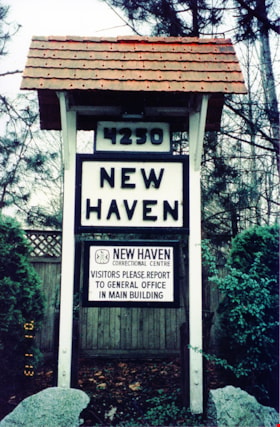
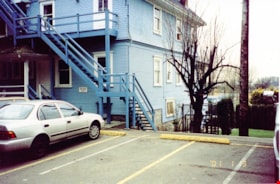
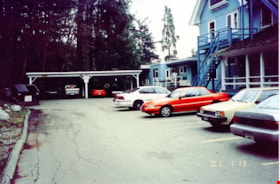
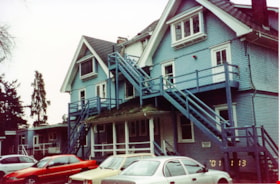
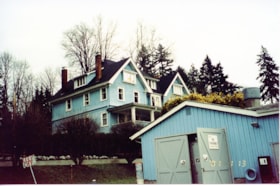
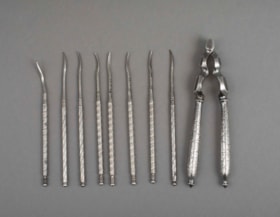
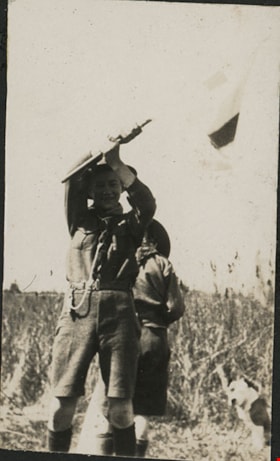

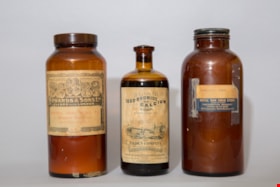
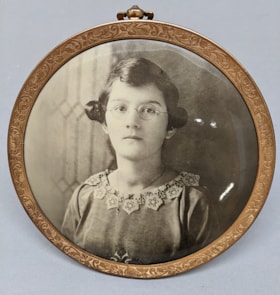
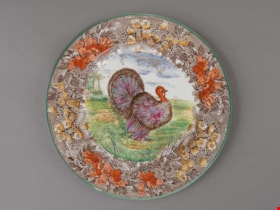
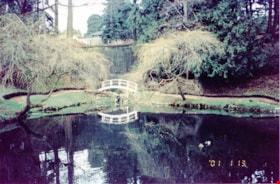
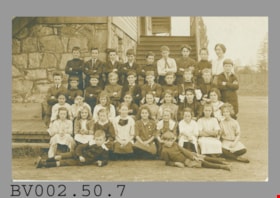
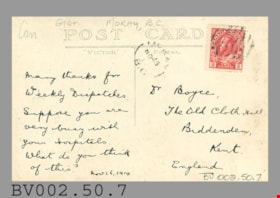
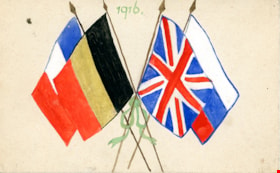
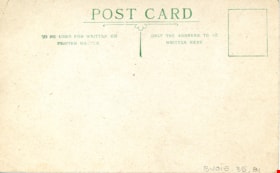

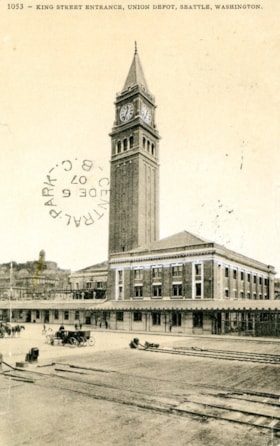
![Postcard showing S.M. Love's house, [190-] thumbnail](/media/hpo/_Data/_BVM_Images/2022/2022_0032_0535_001.jpg?width=280)
![QMS Richard Postle, [1937] thumbnail](/media/hpo/_Data/_BVM_Images/1996/1996_0006_0031_001.jpg?width=280)
![RCAF crew with crashed aircraft, [1945] thumbnail](/media/hpo/_Data/_BVM_Images/2020/2020_0031_0007_001.jpg?width=280)